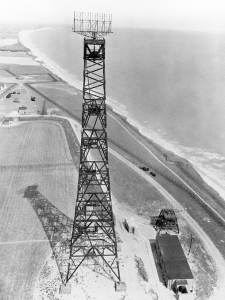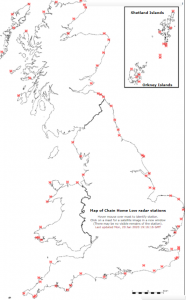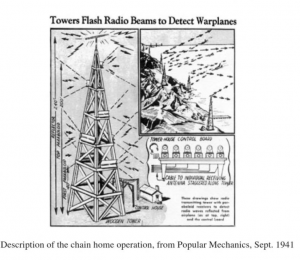Chain Home Low Transmitter
The CHL stations comprised of a pair of broadside aerials 8.5m wide by 3m high on searchlight turntables mounted on pairs of wooden gantries 50m and 3m, for the separate 200 MHz transmitter and receiver respectively. There was a Chain Home Low transmitter and receiver located at the end of St. Aldhelms Head, Worth Matravers.
Chain Home Low Transmitter
In August 1938 the RAF carried out an exercise to test the air defences. This clearly showed the need for better low cover, as Watson-Watt had originally predicted, but no specific requirement was stated until June 1939 when the RAF asked for equipment based on the 1.5 metre coastal defence set to be developed. The Army team was enlarged to provide 24 Chain Home Low (CHL) equipment for the RAF. The CHL stations comprised of a pair of broadside aerials 8.5m wide by 3m high on searchlight turntables mounted on pairs of wooden gantries 50m and 3m for the separate 200 MHz transmitter and receiver respectively.
Airmen, known as “Binders”, operated the mechanical linkage to turn the aerial by pedalling a crude bicycle chain drives to turn the aerials and keep them in step to within two degrees. After detecting a target they had to inch the receiver aerial round to point straight at the target so that the direction could be recorded, the range was given on a CRT, this enabled the map position to be plotted 35.
The main RAF operational radar station at Worth Matravers – going under the name of Renscombe Down: was the Chain Home Low (CHL) station on the St Aldhelm’s Head clifftop, site D.
These stations continued operation after the radar scientists left in May 1942. After the war, the sites were used by the RAF as a training station.
Chain Home Initial Proposal
The initial proposal for the Chain Home service was proposed by Watson-Watt, with the help of his assistant Arnold Wilkins, drafted, in February 1935, with a report titled The Detection of Aircraft by Radio Methods, in response to an enquiry by the Air Ministry. This was presented to the newly formed committee for the scientific survey of air defence, chaired by Sir Henry Tizard.
On 26th of February 1935 a trial took place using the BBCs short-wave (about 50 metres wavelength) radio transmitter at Daventry against a Heyford Bomber. The trial was a success and on 1st September 1936 Watson-Watt became Superintendent of a new establishment under the Air Ministry, Bawdsey Research Station in Bawdsey Manor near Felixstowe.
Sir Robert Watson Watt estimated the strength of the radio signal reflected from an aircraft and discussed the optimum wavelength. He outlined how the range of the target could be measured by the use of short pulses and the use of three range measurements.
Furthermore he suggested that a cathode-ray direction-finder might be developed to measure the bearing and elevation.
It was arranged that a Heyford bomber should fly at a height of 2000 m to and fro in the main beam of the BBC Empire short-wave transmitter at Daventry which radiated 10 kW at 49.8 metre wavelenth. A simple but sensitive arrangement was used to look for reflections from the aircraft.
At a distance of 10 km from the transmitter two horizontal half-wave dipoles were mounted on poles; the dipoles faced the transmitter and were spaced 5 m apart. By means of a phase changer and two receivers the signals from the two dipoles were applied in phase opposition to a cathode-ray tube so that signals arriving directly from the transmitter produced no deflection; signals reflected from an aircraft, arriving at a different angle, were not cancelled and produced a vertical deflection on the cathode ray tube display 36.
in September 1939, at the outbreak of war there were 21 operational Chain Home stations. After the Battle of France in 1940 the network was expanded to cover the west coast and Northern Ireland.
Air Defence System
Radar returns from the equipment were called ‘plots’ and were relayed via telephone to the filter room at the Headquarters of Fighter Command at RAF Bentley Priory, for the East Coast transmitters and Box, near Bath for the West coast transmitters. This was the clever part of Chain Home; The radar was simple and crude and rushed into service but a lot of thought had gone into the entire system of command and control to produce an integrated air defence system. The filter room at Bentley Priory or Box collated the various plots from the different radar stations and produced clean data which was passed up to the map plotters in the command operations room and down to the four regional RAF group controls, which in turn passed the data to their sector operation centres (SOC’s), who controlled the fighter airfields. The data also went sideways to other defence units such as Royal Navy, Army anti-aircraft gun sites and RAF barrage balloon operations. There was also comprehensive liaison with the civil authorities, principally Air Raid Precautions 33.
Chain Home Low Transmitter Receiver
When first deployed, CHL was used both for early detection of low-level targets, as well as a system for tracking individual aircraft over land; unlike CH which was permanently facing over water, CHL could be turned to look in any direction 37.
Here is an image from the Popular Mechanics magazine dated September 1941, this provides one of the few examples in the 1939-1945 era describing the operation of Chain Home. Although, the description is not correct because the transmission tower was separate to the receiving tower, it was 360 feet high and only the receiving tower was constructed of wood.
The Chain Home system derived from the study undertaken by Watson Watt in 1935 used High Frequency radio communications. This suffered from the limitation imposed by the selected frequency being too low to obtain a reasonable angular resolution and the very long 20 microsecond pulses used caused poor range resolution and created difficulties when differentiating between a single and a formation of bombers 38


